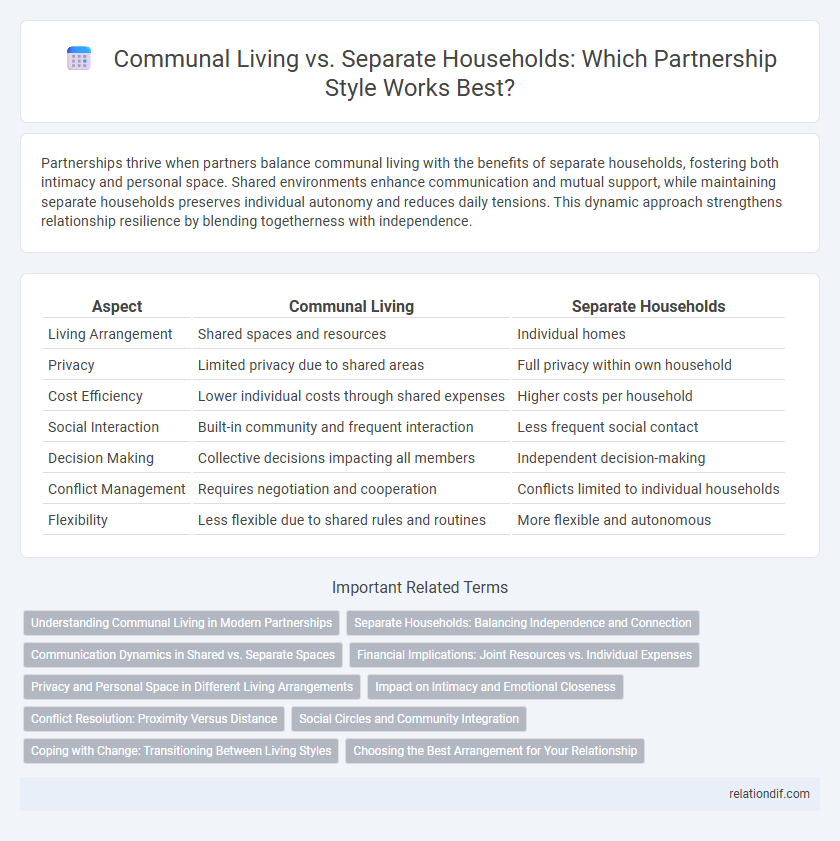Partnerships thrive when partners balance communal living with the benefits of separate households, fostering both intimacy and personal space. Shared environments enhance communication and mutual support, while maintaining separate households preserves individual autonomy and reduces daily tensions. This dynamic approach strengthens relationship resilience by blending togetherness with independence.
Table of Comparison
| Aspect | Communal Living | Separate Households |
|---|---|---|
| Living Arrangement | Shared spaces and resources | Individual homes |
| Privacy | Limited privacy due to shared areas | Full privacy within own household |
| Cost Efficiency | Lower individual costs through shared expenses | Higher costs per household |
| Social Interaction | Built-in community and frequent interaction | Less frequent social contact |
| Decision Making | Collective decisions impacting all members | Independent decision-making |
| Conflict Management | Requires negotiation and cooperation | Conflicts limited to individual households |
| Flexibility | Less flexible due to shared rules and routines | More flexible and autonomous |
Understanding Communal Living in Modern Partnerships
Communal living in modern partnerships involves sharing resources, responsibilities, and daily life, fostering deeper emotional bonds and financial efficiency. This lifestyle contrasts with separate households, where partners maintain individual spaces and independence. Understanding these dynamics highlights the balance between intimacy and autonomy, crucial for tailoring arrangements that suit diverse relationship needs.
Separate Households: Balancing Independence and Connection
Separate households in partnerships allow individuals to maintain personal independence while fostering meaningful connection through intentional communication and shared experiences. This living arrangement supports emotional autonomy and boundaries, promoting a healthy balance between self-growth and relational intimacy. Studies show couples in separate households report higher satisfaction by prioritizing individual space alongside regular quality time together.
Communication Dynamics in Shared vs. Separate Spaces
Communication dynamics in communal living often feature more spontaneous interactions due to shared spaces and frequent proximity, fostering stronger emotional bonds and immediate conflict resolution. Separate households encourage more intentional communication through planned visits or digital means, which can enhance clarity but may reduce everyday emotional exchanges. Understanding these differences helps partners balance closeness and independence while maintaining effective dialogue in either living arrangement.
Financial Implications: Joint Resources vs. Individual Expenses
Pooling financial resources in communal living arrangements often leads to reduced individual expenses through shared costs for housing, utilities, and groceries, enhancing overall economic efficiency. Separate households maintain distinct budgets, requiring individuals to cover the full spectrum of expenses independently, which can increase financial pressure and reduce opportunities for saving. Joint financial management in communal living promotes transparency and accountability, while individual expenses in separate households demand rigorous personal budgeting and financial planning.
Privacy and Personal Space in Different Living Arrangements
Communal living arrangements often challenge privacy norms by sharing common areas and reducing individual personal space, impacting daily routines and intimate boundaries. Separate households provide a higher degree of privacy, allowing partners to maintain personal space and autonomy tailored to individual preferences and needs. Prioritizing privacy in partnership decisions supports mental well-being and relationship satisfaction by balancing closeness with independence.
Impact on Intimacy and Emotional Closeness
Communal living often enhances intimacy and emotional closeness by promoting daily interactions and shared responsibilities, fostering a deeper connection between partners. Separate households, while offering personal space and independence, may reduce spontaneous moments together, potentially weakening emotional bonds over time. Balancing shared experiences with individual autonomy is crucial for maintaining intimacy in either living arrangement.
Conflict Resolution: Proximity Versus Distance
Communal living fosters continuous interaction, enabling immediate conflict resolution through face-to-face communication and shared problem-solving strategies. Separate households provide physical distance that can reduce tension, allowing partners to reflect independently and approach conflicts with a calmer mindset. Balancing proximity and distance is crucial for effective conflict management, influencing emotional regulation and the ability to negotiate solutions within partnerships.
Social Circles and Community Integration
Communal living fosters expansive social circles by encouraging shared spaces and collaborative activities, which enhance community integration and mutual support networks. Separate households often limit daily interactions, resulting in more insular social groups and reduced community engagement. Integrating communal environments with personal autonomy can optimize social connectivity and strengthen collective bonds within neighborhoods.
Coping with Change: Transitioning Between Living Styles
Transitioning from communal living to separate households requires strategic communication and emotional support to manage the shift effectively. Establishing clear boundaries and respecting individual space helps partners maintain connection while adapting to new routines. Developing flexible coping mechanisms ensures both parties can navigate lifestyle changes without compromising relationship stability.
Choosing the Best Arrangement for Your Relationship
Evaluating communal living versus separate households involves assessing how each arrangement supports emotional intimacy, personal space, and financial responsibilities within a partnership. Shared living can enhance daily connection and resource pooling, while maintaining separate households often preserves individual autonomy and reduces potential conflicts. Prioritizing clear communication and aligned expectations ensures the chosen setup strengthens the relationship's long-term health and satisfaction.
Communal living vs Separate households Infographic

 relationdif.com
relationdif.com